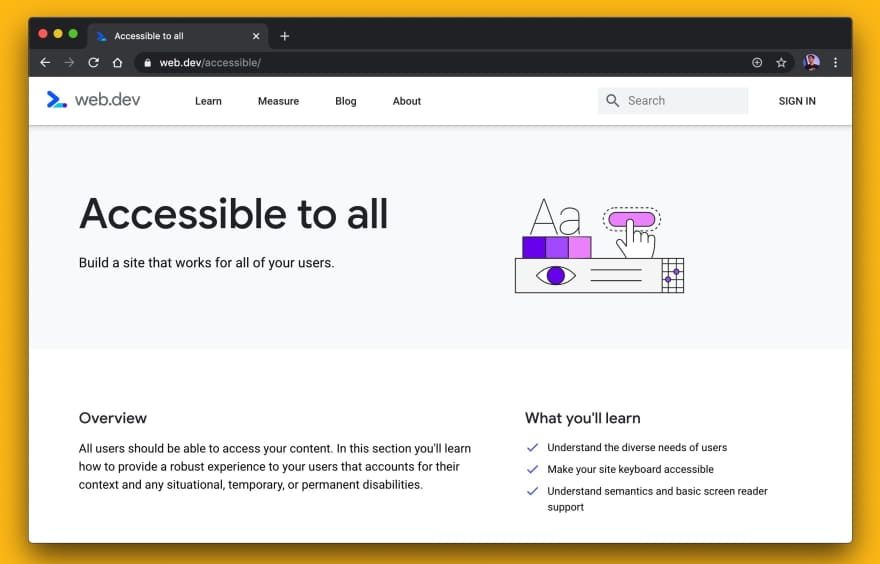Improving accessibility makes your site more useable for everyone.
It's awesome to build sites that are inclusive and accessible to everyone.
There are at least six key areas of disability you can optimize for:
visual, hearing, mobility, cognition, speech, and neural.
Many tools and resources can help here,
even if you’re totally new to Web accessibility.
Over one billion people live with some form of disability.
You might have been in a loud room at some point
trying to hear the conversation around you
or in a low-lighting condition trying to find something in the dark.
Do you remember the frustration you felt with that circumstance?
Now imagine if that temporary condition were permanent.
How different would your experience on the web be?
To be accessible, sites need to work across multiple devices
with varying screen sizes and different kinds of input, such as screen readers.
Moreover, sites should be usable by the broadest group of users,
including those with disabilities.
Here's a sample of just a few disabilities your users may have:
| Vision | Hearing | Mobility |
|---|---|---|
|
|
|
| Cognitive | Speech | Neural |
|
|
|
Visual issues range from an inability to distinguish colors to no vision at all.
- Ensure text content meets a minimum
contrast ratio threshold. - Avoid communicating information
using solely color
and ensure that all text is
resizable. - Ensure all user interface components can be used with assistive technologies
such as screen readers, magnifiers, and braille displays.
This entails ensuring that UI components are marked up
such that accessibility APIs can programmatically determine
the role, state, value, and title of any element.
Tip: The element inspection feature in the Chrome, Edge, and Firefox developer
tools displays a tooltip of CSS properties
that includes a quick check for color contrast ratio.
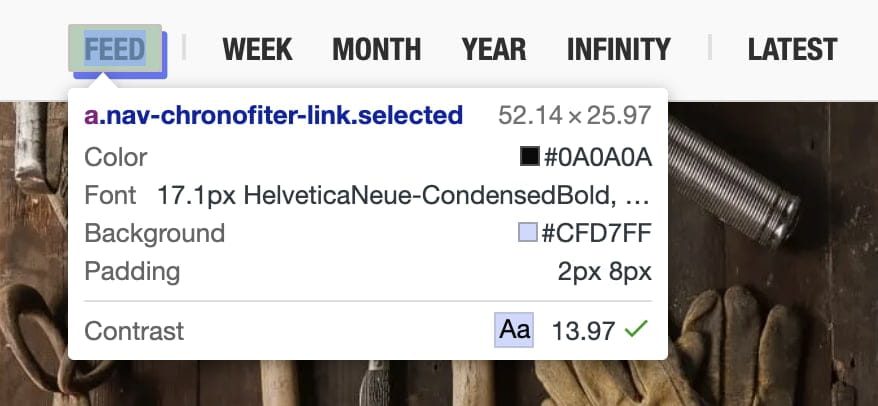
I personally live with low vision, and I often find myself zooming in on sites,
their DevTools, and the terminal.
While supporting zoom is almost never at the top of developers' to-do lists,
it can make a world of difference to users like me.
Hearing issues mean a user may have issues hearing sound emitted from a page.
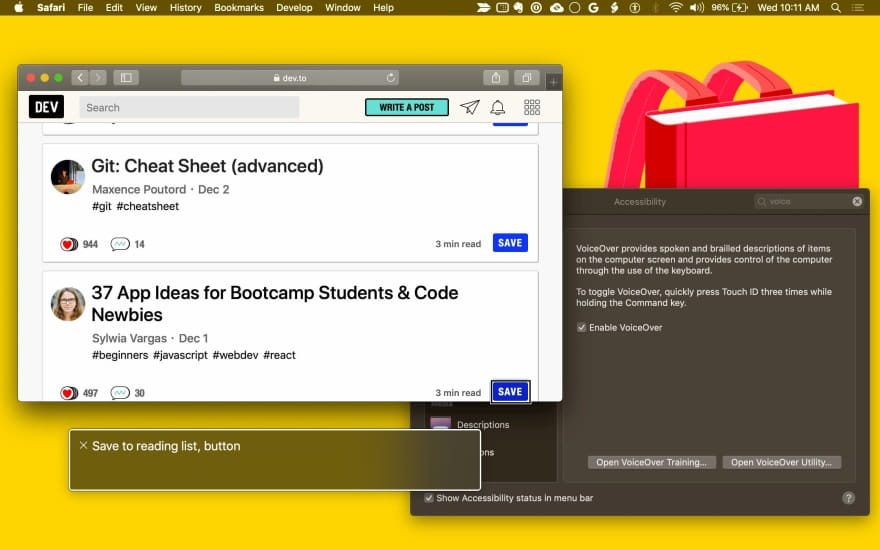
Mobility issues can include the inability to operate a mouse, a keyboard, or a touch screen.
- Make the content of your UI components
functionally accessible from a keyboard
for any actions one would otherwise use a mouse for. - Ensure pages are correctly marked up for assistive technologies — including
screen readers, voice control software, and physical switch controls—which
tend to use the same APIs.
Cognitive issues mean a user may require assistive technologies
to help them with reading text, so it's important to ensure text alternatives exist.
-
Be mindful when using animations. Avoid video and animation that
repeat
or flash, which can cause issues
for some users.The
prefers-reduced-motion
CSS media query allows you to limit animations
and autoplaying videos for users who prefer reduced motion:
@media (prefers-reduced-motion: reduce) {
button {
animation: none;
}
} -
Avoid interactions that are
timing-based.
This may seem like a lot of bases to cover,
but we'll walk through the process for assessing
and then improving the accessibility of your UI components.
Tip: The GOV.UK accessibility team has made some great
accessibility dos and don'ts digital posters
to spread awareness of best practices in your team:
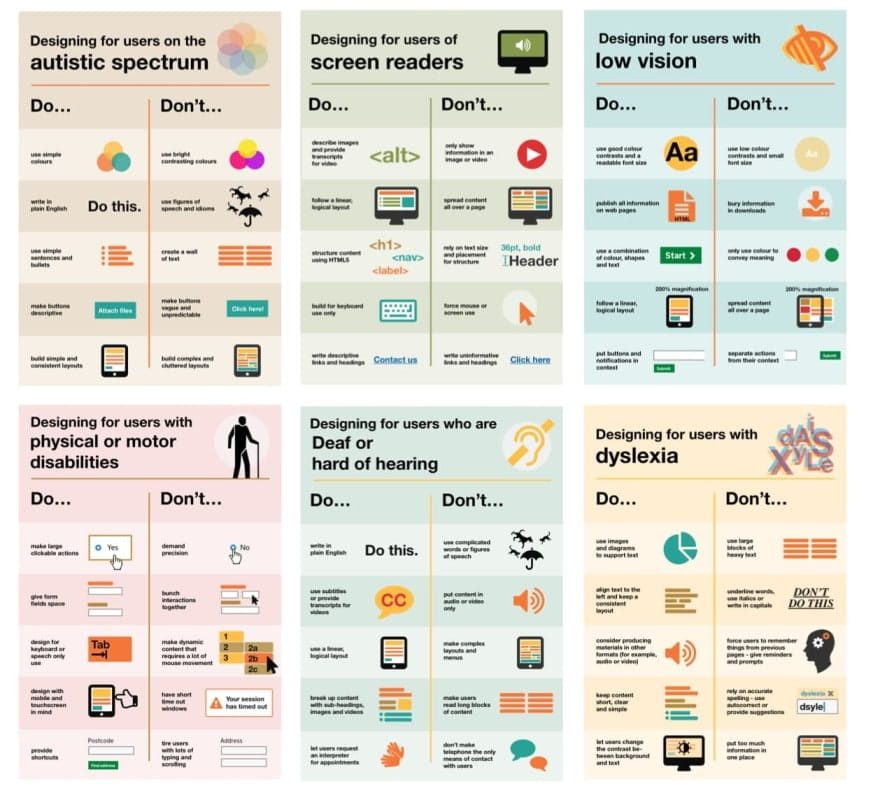
Are your UI components accessible?
Summary (tl; dr)
When auditing your page's UI components for accessibility, ask yourself:
-
Can you use your UI component with the keyboard only?
Does the component manage focus and avoid focus traps?
Can it respond to the appropriate keyboard events? -
Can you use your UI component with a screen reader?
Have you provided text alternatives for any information presented visually?
Have you added semantic information using ARIA? -
Can your UI component work without sound?
Turn off your speakers and go through your use cases.
-
Can your UI component work without color?
Ensure your UI component can be used by someone who cannot see colors.
A helpful tool for simulating color blindness is a Chrome extension called
SEE.
(Try all four forms of color blindness simulation available.)
You may also be interested in the
Daltonize
extension, which is similarly useful. -
Can your UI component work with high-contrast mode enabled?
All modern operating systems support a high contrast mode.
High Contrast
is a Chrome extension that can help here.
Native controls (such as and )
have accessibility built in by the browser.
They are focusable using the Tab key;
they respond to keyboard events (like the Enter, Space, and arrow keys);
and they have semantic roles, states, and properties used by accessibility tools.
Their default styling should also meet the accessibility requirements listed above.
Custom UI components
(with the exception of components that extend native elements like )
do not have any built-in functionality, including accessibility,
so you need to provide it.
A good place to start when implementing accessibility
is to compare your component to an analogous native element
(or a combination of several native elements,
depending on how complex your component is).
Tip: Most browser developer tools support inspecting the accessibility tree of a page.
In Chrome DevTools, this is available via the Accessibility tab in the Elements panel:
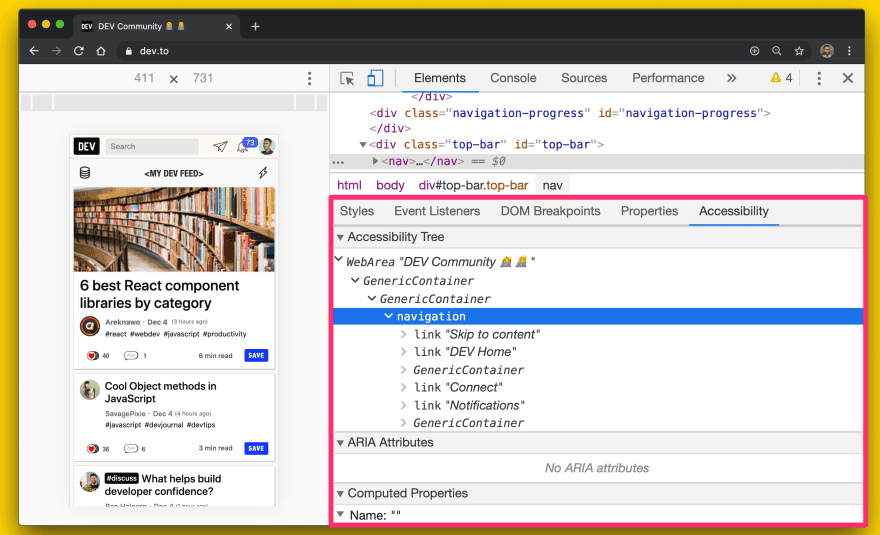
Firefox also has an Accessibility panel:
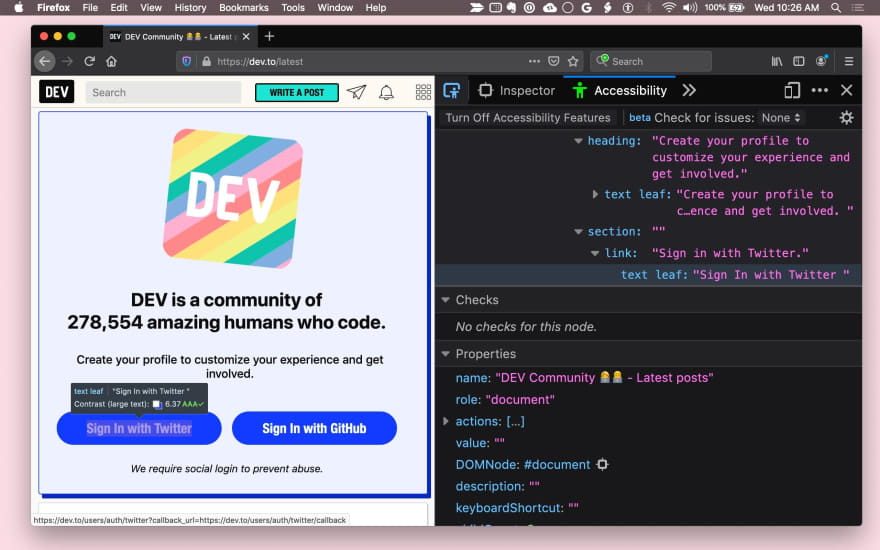
Safari exposes accessibility information in the Elements panel's Do not give tab.
The following is a list of questions you can ask yourself when attempting to make your UI components more accessible.
Can your UI component be used with the keyboard alone?
Ideally, ensure that all functionality
in your UI component can be accessed via keyboard.
When designing your user experience,
think about how you would use your element with the keyboard alone
and figure out a consistent set of keyboard interactions.
First, ensure that you have a sensible focus target for each component.
For example, a complex component like a menu may be one focus target within a page
but should then manage focus within itself so that the active menu item always takes focus.
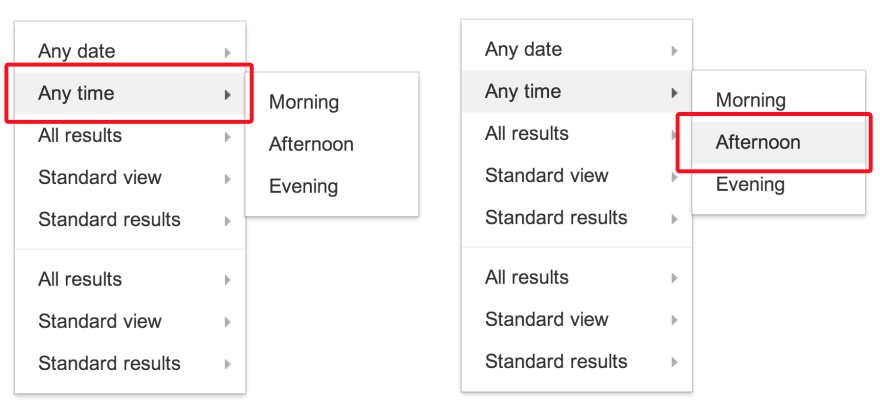
Using tabindex
The tabindex attribute allows elements and UI components to be focused using the keyboard. Keyboard-only and assistive technology users both need to be able to place keyboard focus on elements to interact with them. Native interactive elements are implicitly focusable, so they don't need a tabindex attribute unless you wish to change their position in the tab order.
There are three types of tabindex values:
-
tabindex = "0"is the most common and places the element in the natural tab order (defined by the DOM order). -
to
tabindexvalue greater than 0 places the element in a manual tab order — all elements in the page with a positivetabindexvalue are visited in numerical order before elements in the natural tab order. -
to
tabindexvalue equal to -1 causes the element to be programmatically focusable, but not in the tab order.
For custom UI components, always use tabindex values of 0 or -1, as you won't be able to determine the order of elements on a given page ahead of time — and even if you did, the order may change. TO tabindex value of -1 is particularly useful for managing focus within complex components as described above.
Also ensure that focus is always visible, whether by allowing the default focus ring style or by applying a discernible custom focus style. Remember not to trap keyboard users — they should be able to move focus away from an element using only the keyboard.
You may also be interested in the roving tabindex or aria-activedescendant approaches,
covered over on MDN.
Using autofocus
The HTML autofocus attribute allows an author to specify
that a particular element should automatically take focus
when the page is loaded.
autofocus is already supported on
all web form controls,
including buttons.
To autofocus elements in your own custom UI components,
call the focus () method,
supported on all HTML elements that can be focused
(for example, document.querySelector ('myButton'). focus ()).
Adding keyboard interaction
Once your UI component is focusable,
provide a good keyboard interaction story
when a component is focused by handling appropriate keyboard events.
For example, allow the user to use arrow keys to select menu options
and Space or Enter to activate buttons.
The ARIA design patterns guide
provides some guidance here.
Finally, ensure that your keyboard shortcuts are discoverable.
A common practice is to have a keyboard shortcut legend (on-screen text)
to inform the user that shortcuts exist.
For example, «Press? for keyboard shortcuts. »
Alternatively, a hint such a tooltip can be used
to inform the user about a shortcut.
The importance of managing focus cannot be overstated.
One example is a navigation drawer.
If you add a UI component to the page,
you need to direct focus to an element inside of it;
otherwise, users may have to tab through the entire page to get there.
This can be a frustrating experience,
so be sure to test focus for all keyboard navigable components in your page.
Tip: You can use Puppeteer
to automate running keyboard accessibility tests for toggling UI states.
WalkMe Engineering
has a great guide on this I recommend reading.
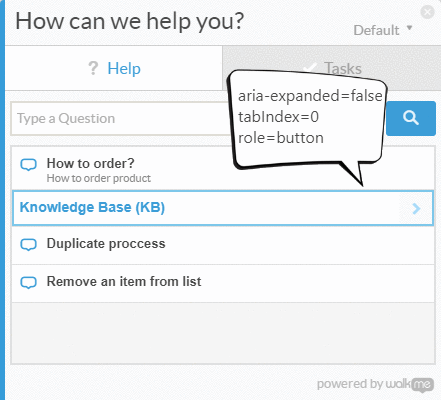
const category = await page.$(`.category`);
expect(await page.evaluate(elem => elem.getAttribute(`role`), category)).toEqual(`button`);
expect(await page.evaluate(elem => elem.getAttribute(`tabindex`), category)).toEqual(`0`);
expect(await page.evaluate(elem => window.document.activeElement === elem, category)).toEqual(true);
expect(await page.evaluate(elem => elem.getAttribute(`aria-expanded`), category)).toEqual(`false`);
await page.keyboard.press('Space');
expect(await page.evaluate(elem => elem.getAttribute(`aria-expanded`), category)).toEqual(`true`);
Can you use your UI component with a screen reader?
Around 1–2% of people use a screen reader.
Can you understand all important information
and interact with the component using the screen reader and keyboard alone?
The following questions should help you address screen reader accessibility.
Do all components and images have meaningful text alternatives?
Wherever information about the yam or purpose
of an interactive component is conveyed visually,
provide an accessible text alternative.
For example, if your UI component only displays a gear icon
to indicate that it's a settings menu,
it needs an accessible text alternative, such as «settings,»
that conveys the same information.
Depending on context,
you can provide a text alternative using an alt attribute,
an aria-label attribute, an aria-labelledby attribute,
or plain text in the Shadow DOM.
You can find general technical tips in WebAIM Quick Reference.
Any UI component that displays an image should provide a mechanism
for providing alternative text for that image, analogous to the alt attribute.
Do your components provide semantic information?
Assistive technology conveys semantic information
that is otherwise expressed to sighted users via visual cues
such as formatting, cursor style, or position.
Native elements have this semantic information built-in by the browser,
but for custom components you need to use
ARIA to add the information.
As a rule of thumb, any component that listens to a mouse click or hover event
should not only have some kind of keyboard event listener,
but also an ARIA role and potentially ARIA states and attributes.
For example, a custom UI component might take an ARIA role of slider,
which has some related ARIA attributes: aria-valuenow, aria-valuemin and aria-valuemax.
By binding these attributes to the relevant properties on your custom component,
you can allow users of assistive technology to interact with the element,
change its value, and even cause the element's visual presentation to change accordingly.

<fancy-slider role="slider" aria-valuemin="1" aria-valuemax="5" aria-valuenow="2.5"></fancy-slider>Can users understand everything without relying on color?
Color shouldn't be used as the only means of conveying information,
such as indicating a status, prompting the user for a response,
or visualizing data.
For example, if you have a pie chart,
provide labels and values for each slice
so users who have visual impairments can understand the information
even if they can't tell where the slices begin and end:
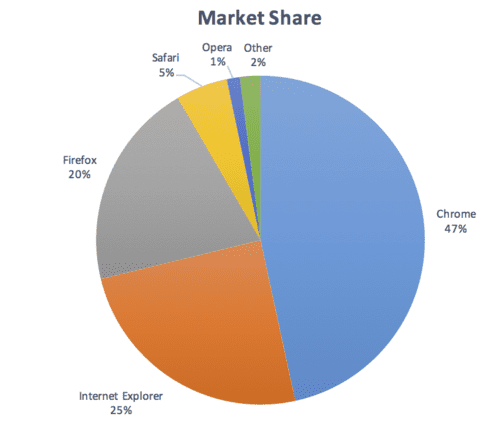
Is there sufficient contrast between text and images and their background?
Any text content displayed in your component should meet the
minimum WCAG AA-level contrast threshold.
Consider providing a high-contrast theme that meets the
higher AAA threshold,
and ensure that user agent style sheets can be applied
if users require custom contrast or different colors.
You can use this Color Contrast Checker
as an aid when designing your component.
Is the moving or flashing content in your components stoppable and safe?
Content that moves, scrolls, or blinks for more than five seconds
should be able to be paused, stopped or hidden.
In general, avoid flashing content.
If something must flash, make sure it flashes no more than three times per second.
A number of tools are available that can assist with
debugging the accessibility of your visual components.
- Ax provides automated accessibility testing
for your framework or browser of choice.
Ax Puppeteer
can be used for writing automated accessibility tests. - The Lighthouse
Accessibility audits provide helpful insights for discovering common accessibility issues.
The accessibility score is a weighted average of all accessibility audits
based on Ax user impact assessments.
For monitoring accessibility via continuous integration, see Lighthouse CI.
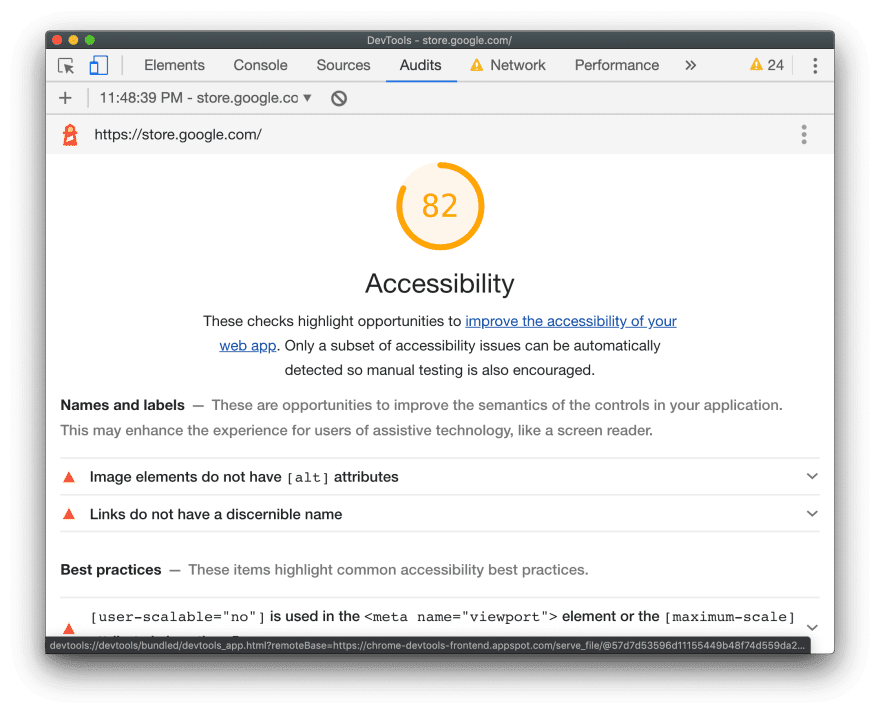
-
Tenon.io is useful for testing common accessibility problems.
Tenon has strong integration support across build tools, browsers (via extensions), and even text editors. -
There are many library- and framework-specific tools
for highlighting accessibility issues with components.
For example, web.dev
explains how to use eslint-plugin-jsx-a11y
to highlight accessibility issues for React components in your editor: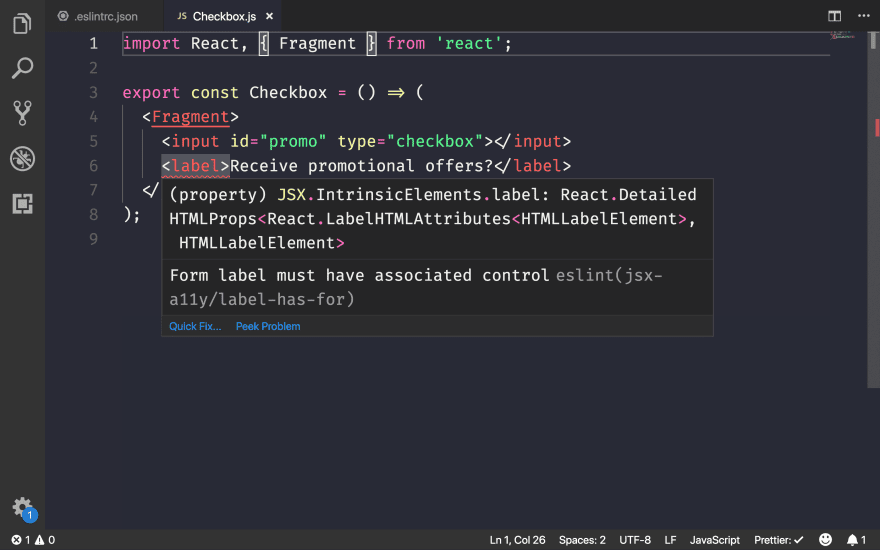
If you use Angular, codelyzer
provides in-editor accessibility audits too: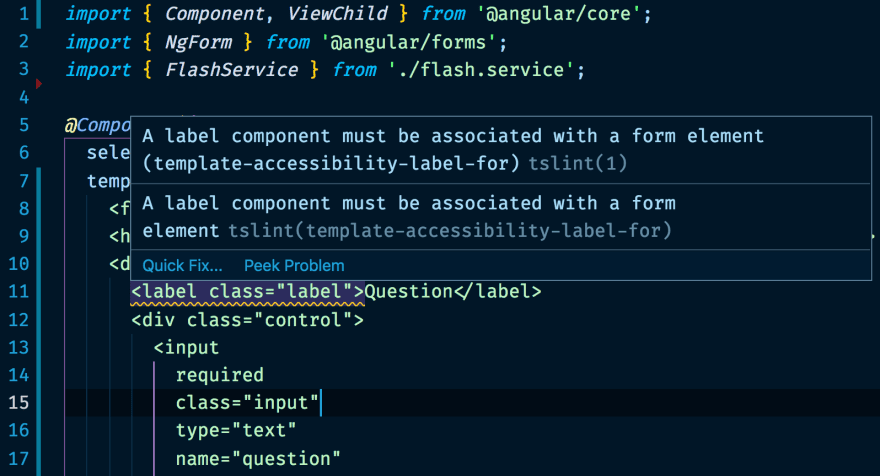
-
You can examine the way that assistive technologies see web content by using
Accessibility Inspector (Mac)
or Windows Automation API Testing Tools
and AccProbe (Windows).
You can also see the full accessibility tree that Chrome creates
by navigating tochrome://accessibility. -
The best way to test for screen reader support on a Mac is using the VoiceOver utility.
Use⌘F5to enable or disable it,Ctrl + Option ← →to move through the page,
andCtrl + Shift + Option + ↑ ↓to move up and down the accessibility tree.
For more detailed instructions,
see the full list of VoiceOver commands
and the list of VoiceOver Web commands. -
tota11y is a useful visualizer
for assistive technology issues built by Khan Academy.
It's a script that adds a button to your document that triggers several plugins
for annotating things like insufficient contrast ratio and other a11y violations. -
On Windows, NVDA is a free, open source screen reader
that's fully featured and rapidly gaining in popularity.
However, note that it has a much steeper learning curve for sighted users than VoiceOver. -
ChromeLens helps develop for the visually impaired.
It also has great support for visualizing keyboard navigation paths.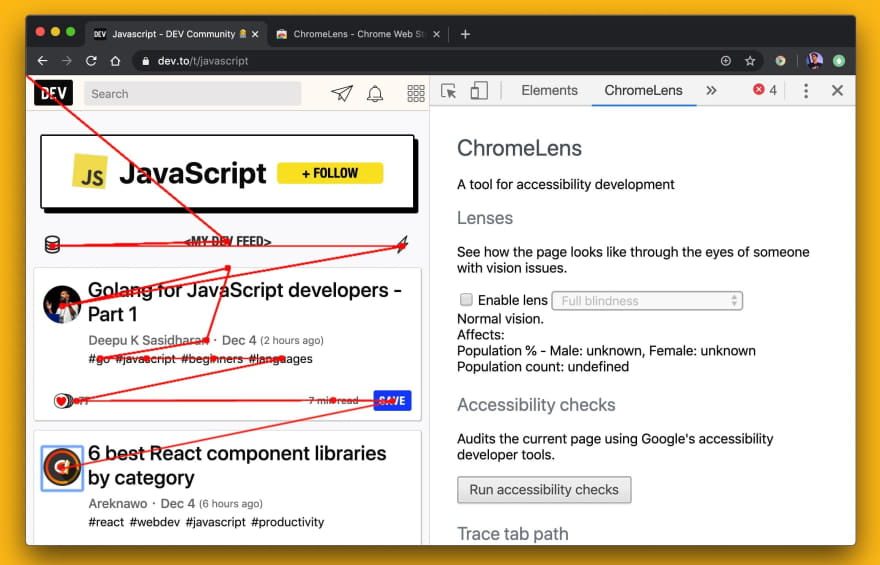
-
ChromeVox is a screen reader available as a Chrome extension and built into ChromeOS devices.
Conclusions
We still have a long way to go to improve accessibility on the web.
Per the Web Almanac:
- 4 out of every 5 sites have text that easily blends into the background, making it unreadable.
- 49.91% of pages still fail to provide
altattributes for some of their images. - Only 24% of pages that use buttons or links include textual labels for them.
- Only 22.33% of pages provide labels for all their form inputs.
To learn more about accessibility fundamentals and help improve those statistics,
I recommend the Accessible to all docs on web.dev.
There's a lot we can do to build experiences that are more accessible for everyone.
